2021 Volume 90 Issue 3 Pages 239-246
2021 Volume 90 Issue 3 Pages 239-246
Here, we describe the current status of energy-saving techniques in greenhouse heating and countermeasures for high summer temperatures, and then introduce an outline and the performance of a newly developed New Root-zone Environmental Control System (N.RECS) and the effects of this system on flower production. Temperature control techniques used in protected horticulture include those that control the air temperature of the entire greenhouse space and those that control the local temperature of the plants. The running costs of the air temperature control techniques are expensive and the cooling capacity in the summer are inadequate for actual cultivation. Local temperature control techniques have relatively low running costs and can adequately cool plants during high temperature periods, but they are crop-specific and not versatile. Therefore, we developed a N.RECS that can heat and cool the root-zone of various plants with low running costs. N.RECS was produced by combining aluminum heat exchange panels, insulated pot trays and an air-source heat pump cold/hot water supply system. By using N.RECS, the root-zone temperature was maintained at 25°C when the air temperature was about 5°C during the winter and cooled to below 23°C when the air temperature was about 35°C during the summer. Root-zone heating of six potted flowers and cut flowers in the winter promoted growth and flowering and achieved energy savings of about 30% compared to conventional heating.
When the two flower species, which are susceptible to high temperature, were grown under high temperature conditions, about half of the plants died, but root-zone cooling allowed all the plants to grow healthily. Therefore, it is concluded that N.RECS is a practical system that allows for both energy-saving cultivation in the winter and cooling cultivation in the summer. In addition, root-zone temperature is an environmental control parameter that should be controlled in future agricultural production; by applying root-zone temperature control as a standard technology for agricultural production, the growth of plants can be controlled more flexibly and more energy can be saved.
The major heating techniques in protected horticulture are hot-air and hot-water heating systems that use combustion of fossil fuels such as fuel oil, which account for about 95% of the total heating area (Japan greenhouse horticulture association, 2015). The heating costs fluctuate greatly depending on oil prices and exchange rates, causing instability in horticulture crop production. Although heat pumps have a high coefficient of performance (COP) and excellent heating efficiency and can be used in combination with hot-air heating systems to reduce the consumption of fossil fuels, their area of installation is still small in Japan (0.7%) (Japan greenhouse horticulture association, 2015).
The number of annual days with air temperatures above 35°C during summer has increased significantly since the mid-1990s, and the number of annual days with minimum air temperatures above 25°C has also increased (Japan Meteorological Agency, 2018). In flower production, high temperatures result in suppressed growth, delayed flowering, abnormal flower morphology, reduced flower vase life, discolored flowers, early flowering, rosette induction and devernalization (Shibata, 1995). Therefore, there is an urgent need to develop countermeasures to high summer temperatures. Here, we describe the current status of energy-saving techniques in greenhouse heating and countermeasures against high summer temperatures, and then introduce an outline and the performance of a newly developed New Root-zone Environmental Control System (N.RECS) and the effects of this system on flower production.
In Japan, the Cabinet approved a countermeasure plan against global warming in May 2016, and the goal is to reduce carbon dioxide emissions in protected horticulture by 1.24 million tons by 2030 compared to the 2013 level. In order to achieve this goal, the Ministry of Agriculture, Forestry and Fisheries (MAFF) has proposed the use of technologies such as energy saving equipment, thermal insulation of greenhouses, and temperature control for energy saving as countermeasures against climate change and global warming in the agricultural sector (MAFF, 2018). In recent years, a number of temperature control techniques have been investigated to improve energy saving, including variable heating temperature management and localized temperature control of horticultural crops.
In general, heating of greenhouses is kept at a fixed level to ensure that the minimum temperature does not fall below a set value. End of day heating (EOD-heating) is an air temperature management technique that increases the temperature for a few hours from the beginning of the dark period compared with a reference temperature and reduces the temperature for the rest of the dark period. Usually, the reference temperature for the dark period is the minimum temperature applied in conventional cultivation. Thus, this technique is expected to reduce the total heat input. EOD-heating in cut flower cultivation of spray chrysanthemum during winter reduced heat consumption by 15% during a short-day treatment period (Douzono et al., 2012). Kawanishi et al. (2012) investigated the application of EOD-heating using 21 spray chrysanthemum cultivars. The results showed that EOD-heating had no significant effects on flowering on almost all cultivars, and it was estimated that heating costs were reduced by 32%. In spray carnations (Baba et al., 2013), EOD heating was expected to significantly reduce heating costs with no differences in yields or quality even when the night air temperature was lowered to 5°C. As mentioned above, the energy saving effect of EOD-heating is shown mainly in cut flower production.
Local heatingVarious techniques to control the local temperature of plants have been developed for vegetables, cut flowers and pot flowers.
Kawasaki et al. (2010, 2011) installed hot air ducts near the apex of the stem and the flower clusters of tomatoes to provide local heating. As a result, the fruit quality was improved, and fuel consumption was reduced compared to conventional control.
Forcing culture of eggplant requires a lot of fossil fuel to maintain a minimum air temperature of 12°C during winter. Moriyama et al. (2011) found that heating the basal part of the main stem with electric heating wires resulted in yields comparable to those of conventional cultivation, even at a minimum temperature of 10°C, and reduced heating costs significantly. Based on this finding, Moriyama and Oku (2012) developed a system that used hot air ducts to heat the basal part of the eggplant as an energy-saving technique with low installation costs.
Growth of June-bearing strawberries grown in a greenhouse with a minimum air temperature of 8°C was enhanced by crown heating at 21°C (Sato and Kitajima, 2010). Kim et al. (2009a, b) found that flower bud development and flowering were enhanced, and fruit yield increased, when a medium was heated in strawberries during winter.
Roses require a high air temperature during winter and are generally grown in greenhouses at a minimum air temperature of 18°C. Heating costs put pressure on growers’ operations, so a heating technique for the basal part of roses was developed to reduce heating costs (Kanagawa Agri. Tech. Cent., 2012). In this technique, two pipes were installed at the basal part of shoot-bending roses, and the water at 30°C was circulated through the pipes to heat the basal part. The combination of lowering the air temperature in the greenhouse to 15°C and heating the basal part of roses improved the productivity of cut flowers and reduced heat consumption by about 20%. Inamoto et al. (2019) applied the technique of strawberry crown heating to gerbera cultivation and found that the crown heating of gerbera with hot water tubes or stainless-steel tape heaters promoted flower stem development and elongation. Hamada (1991) studied the effect of soil temperature on the growth and yield of gerbera for cut flowers. The results showed that heating the soil temperature to 20–23°C resulted in vigorous growth and improved cut flower quality.
Vogelezang (1988, 1990, 1991, 1992) reported growth and flowering for two types of Saintpaulia cultivars, Begonia × hiemalis, Ficus benjamina, Scefflera arboricola ‘Compacta’, Spathiphyllum ‘Mauna Loa Brilliant’, and Guzmania minor ‘Empire’ were promoted by root-zone heating using a heated aluminum bench. Olberg and Lopez (2016) suggested that when root-zone heating > 24°C was utilized during the final stage of poinsettia production, air temperatures could be reduced. Olberg and Lopez (2017) also reported that the root-zone heating of petunia by the bench top heating system can produce high-quality plants in a short period.
As described above, the applications of EOD-heating and local heating techniques have been investigated in various horticultural crops to reduce heating costs during winter, and some of these techniques have been put to practical use. EOD-heating can be applied simply by changing the air temperature management in the greenhouse, which has the advantage that existing heating systems can be used for various crops. Local heating techniques are an attractive technology with high energy-saving effects compared to EOD-heating. However, the heating parts differ for each crop, so the heating devices are dedicated to a particular crop and are mostly useless for other crops.
MAFF (2018) proposed the use of cooling and dehumidification functions as a way of utilizing the multi-functionality of heat pumps year-round. At present, day cooling with heat pumps has been used only in the cultivation of Phalaenopsis orchids, but since the running costs are low at night when the temperature is relatively low and there is no solar radiation, night cooling has also been tried in other floriculture plants.
In summer rose production, the growth was retarded at night temperatures above 25°C and day temperatures above 35°C, resulting in reduced fresh weight of cut flowers, stem diameter, and flower size, as well as lower yields (Matsufuru, 2012). Kajihara et al. (2015) investigated the effect of EOD-cooling and EON (end of the night) cooling for four hours on the yield and quality of rose cut flowers in order to develop an efficient night cooling technique during the summer using a heat pump. The results showed that both EOD-cooling and EON-cooling were efficient air temperature control techniques compared to all night cooling.
The optimum growing temperature for oriental hybrid lilies is 15–25°C, and in the early growth period, the stem root development stage, it is 10–15°C (Oda, 2006). In retarding culture, the quality of cut flowers is reduced due to poor development of stem roots caused by high temperature. Ninomiya et al. (2012) investigated the effects of heat pump cooling during summer on the growth of oriental lilies. Night cooling at 22°C for 3–4 weeks after planting in early August prevented the suppression of elongation growth and reduced calyx splitting due to high air temperature. In rose cut flower production, fog cooling during day reduced the air temperature in the greenhouse by 6–7°C below the outside air temperature and increased the length and number of cut flowers (Matsufuru and Kato, 2013).
Local coolingVarious techniques for local cooling have been investigated. Nakano et al. (2009) developed a medium solidified with heat-adhesive polyester fibers, allowing advanced evaporative cooling from the medium surface and the growth of plants without pots in pot culture. The temperature of the medium was decreased by more than 5°C compared to the conventional plastic pot culture, and this promoted the growth of cyclamen and pansy in summer.
Kawasaki and Ahn (2015) found that local cooling near the flower clusters of tomatoes during the night with a heat pump reduced the air temperature and surface temperature of plants near the flower clusters by about 2°C, which reduced high temperature injury.
Yamazaki et al. (2007) developed equipment to prevent an increase in medium temperature in strawberry cultivation by using the vaporization heat of the medium. When strawberries were grown with this equipment, the medium temperature was consistently 0.5 to 3.0°C lower than that of the conventional method, which resulted in more uniform flower bud formation. Okimura (2009) developed temperature control equipment for local cooling of strawberry crowns. The tubes in contact with the strawberry crowns were circulated with cold water to cool the crown. Using this equipment, the fruit yield increased when the crown was maintained at around 20°C, and stable strawberry production was achieved.
As mentioned above, heat pump cooling is practically limited to use only during the night. Fog cooling has a cooling effect of only about 5°C compared to the outside air temperature and has almost no cooling effect in humid, rainy weather or at night. Although local cooling techniques are highly effective both day and night, it is a crop-specific technique because the parts to be cooled differ for each crop, such as the medium, crown, flower clusters and so on.
Energy saving techniques for heating in winter and cooling techniques under high temperature conditions in protected horticulture have been described. No system could achieve both energy saving for heating in winter and cooling in summer with one type of equipment. Growers have to install both heating and cooling equipment, which is costly. Therefore, if a single system could achieve effectively both winter heating and summer cooling to support practical cultivation, it would make significant contributions to cost savings for growers.
The goal of the Root-zone Environment Control System (RECS) is to provide integrated control of the root-zone environment, including soil moisture, nutrients, and temperature. Since technologies for managing soil moisture and nutrients have already been developed, we focused on developing technologies for managing root-zone temperature.
A prototype of the RECS for potted flowers was tested to determine the effects of root-zone temperature (RZT) on growth and flowering. In RECS, seedlings were potted in porous pots without drainage holes, and the pots were placed on a pool bench filled with water to regulate the RZT by heating and cooling the water in the pool. Irrigation water was supplied slowly through the wall of each porous pot from the pool to the soil inside the pot.
Seedlings of verbena (Verbena × hybrida) and geranium (Pelargonium × hortorum) were used and the effects of root-zone heating (RZ heating) on the growth and flowering using RECS were assessed (Kubota et al., 2013). When verbena plants were grown under 15, 20, and 25°C RZ heating, the growth of the top was markedly promoted at 25°C RZ heating, and the dry weight of the whole plant at 25°C RZ heating increased ca. 1.5 times compared to that of 15°C RZ heating. In addition, potted geranium flowers were grown in a greenhouse during winter, and the minimum air temperature/RZ heating were set at 8°C/18°C, 8°C/13°C, and 13°C/non-heating. The growth of the top, flowering rate, and number of florets increased with 18°C RZ heating, and the dry weight of the whole plant increased ca. 2 times compared to non-heating (Fig. 1).
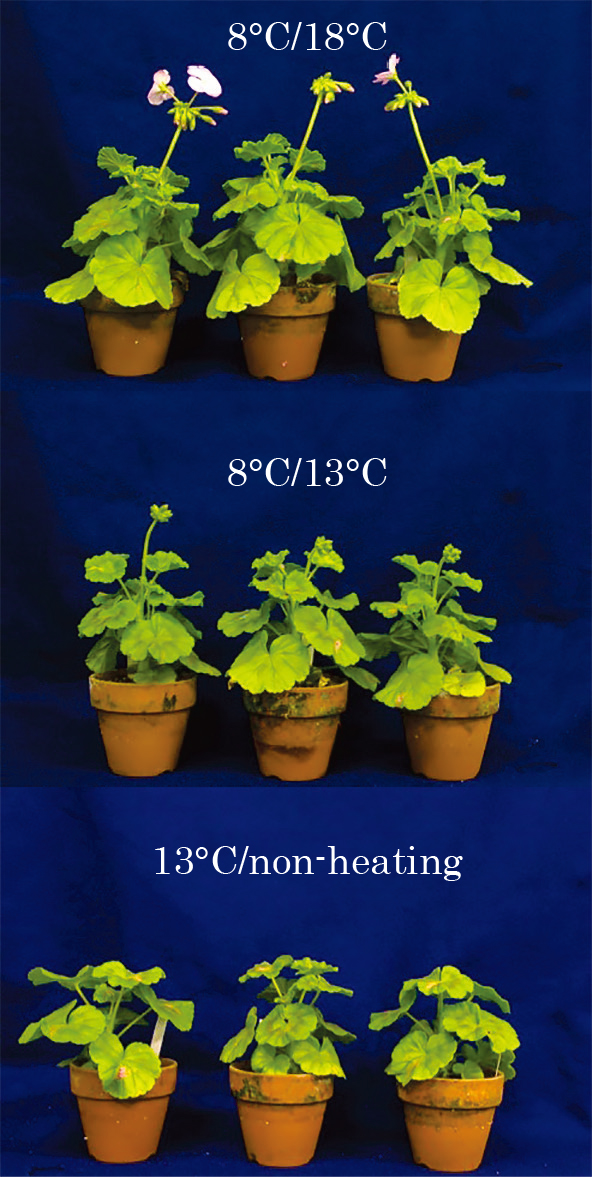
Effects of root-zone (RZ) heating on growth and flowering of geranium (Pelargonium × hortorum) during winter. The minimum air temperature/RZ heating were set at 8°C/18°C, 8°C/13°C, and 13°C/non-heating. The growth and flowering at 8°C/18°C were promoted compared to those of other treatments.
Impatiens (Impatiens walleriana Hook. f.) seedlings were used to investigate the effects of RZ heating on growth, flowering, and energy consumption (Muramatsu et al., 2017). Four combinations of minimum air temperatures and RZ heating: 8°C/non-heating, 13°C/non-heating, 8°C/13°C, and 8°C/18°C, were set, respectively, and the impatiens plants were cultivated from February to April in a greenhouse. The number of leaves, leaf area, and dry weight of the top increased with rising RZT, and there was a close relationship between growth and RZT. The flowering season was about 10 days earlier at 8°C/13°C and 8°C/18°C than that at 13°C/non-heating. Energy consumption at 8°C/18°C, when growth and flowering were the most accelerated, was reduced by about 32% compared with that of 13°C/non-heating.
Cyclamen (Cyclamen persicum) seedlings are susceptible to high temperatures in summer; this delays their flowering and makes it impossible for them to be shipped at the end of the year. Usually, growers who grow cyclamen in the lowlands move their plants to the highlands during the summer season to avoid delayed flowering. Therefore, we examined the effects of root-zone cooling (RZ cooling) during the summer on growth and flowering of cyclamen (Muramatsu et al., 2015). RZT were cooled at 20, 23, and 26°C during the summer using RECS. Vegetative growth was promoted at 23°C RZ cooling compared with non-cooling. Flowering at 20°C RZ cooling started in the middle of October, and the flowering rates increased with a fall in the RZT: 20% at non-cooling, 44% at 26°C cooling, 60% at 23°C cooling, and 88% at 20°C cooling (Fig. 2). The results showed that RZ cooling of 20 and 23°C, even at high air temperatures exceeding 30°C, promoted flowering significantly more than that of non-cooled plants, allowing for early shipment by the end of the year.
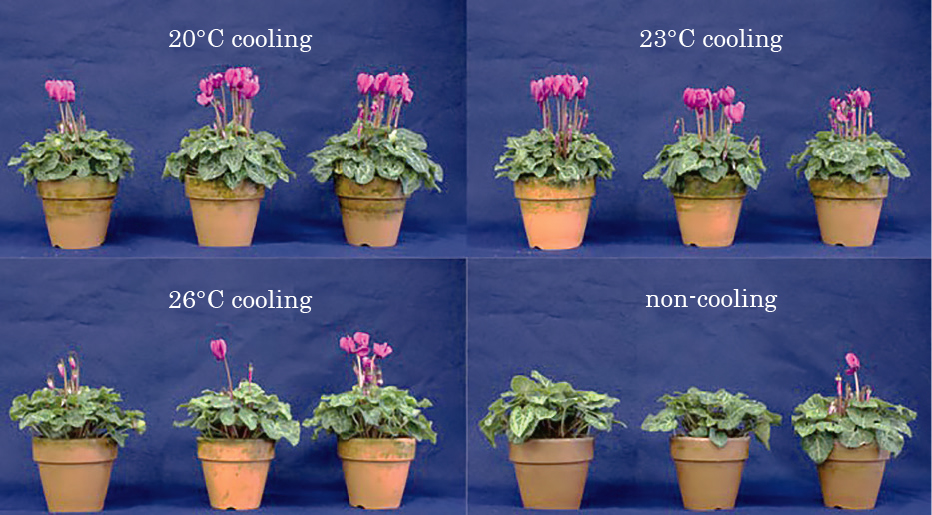
Effects of root-zone (RZ) cooling on growth and flowering of cyclamen during summer. Maximum air temperature increased to 30–35°C during the experiment. RZ cooling of 20–23°C significantly promoted flowering compared to that of non-cooling plants.
As described above, the control of RZT was shown to have significant effects on the growth and flowering of potted floriculture plants. On the other hand, these experiments were conducted on a pool bench filled with water using porous pots, which was a very different system from the conventional cultivation, so it was necessary to develop equipment to make the RZT control technology practical. Therefore, a N.RECS, which can control the RZT of vinyl pots commonly used in potted plant production, was developed with the collaboration of industry and academia.
The structure and mechanism of the N.RECS are shown in Figure 3 (Kubota et al., 2018). Aluminum heat-exchange panels were laid on top of expanded polystyrene (EPS) insulation panels, and cross-linked polyethylene pipes (PEP) were laid inside the heat-exchange panels to circulate cold or hot water. Cold water (7–10°C) or hot water (35–40°C) produced by an air-source heat pump cold/hot water supply system was circulated through the PEP. An electric three-way valve (V) was installed in the circulation circuit. A soil temperature sensor (S) connected to the controller measures the RZT and the controller opened and closed the V to adjust the actual RZT in the pot to a set value of RZT. Since heating and cooling of pots were not fully effective if the pots were placed directly on top of the heat exchange panel without insulation materials, an insulated pot tray made of EPS was placed on top of the heat exchange panel and the pots were placed in the insulated pot tray to maintain the RZT. Figures 4 and 5 show the control of RZT by N.RECS in winter and summer, respectively. The RZT could be maintained at about 25°C even in a non-heated greenhouse at 5°C of minimum air temperature in winter (Fig. 4). In summer, the RZT of non-cooling increased to 30–35°C consistent with the changes in air temperature (Fig. 5), but 20°C RZ cooling was maintained in a range from 20 to 23°C of RZT. Thus, it is concluded that N.RECS has the ability to perform both root zone heating and root zone cooling under various conditions throughout the year.
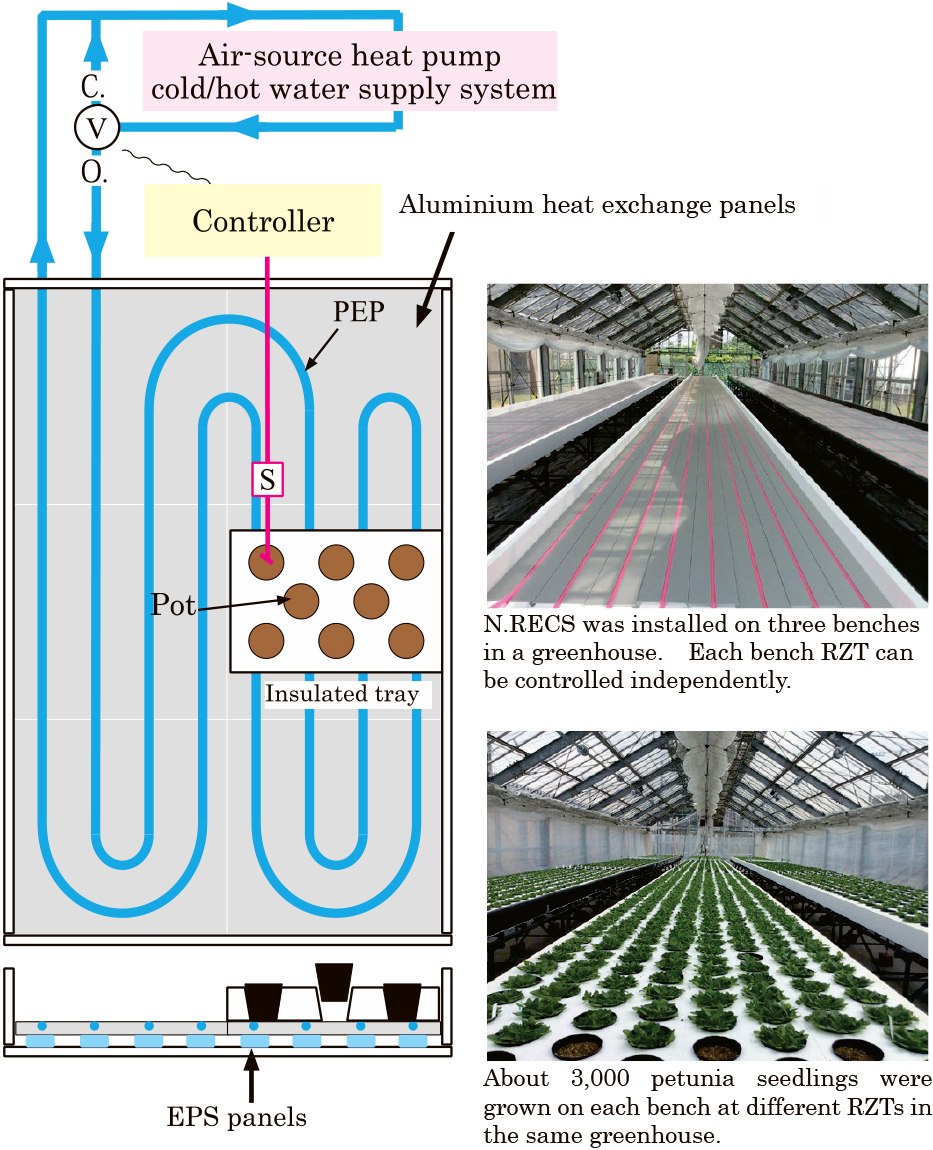
Structure and mechanism of the N.RECS. V: electric three-way valve, S: sensor for soil temperature, PEP: cross-linked polyethylene pipe. Hot or cold water was supplied from a heat pump system to aluminum heat exchange panels through a three-way electric valve. A soil temperature sensor (S) connected to the controller measures the root-zone temperature (RZT) and the controller opens and closes the V to adjust the actual RZT in the pot to a set value.
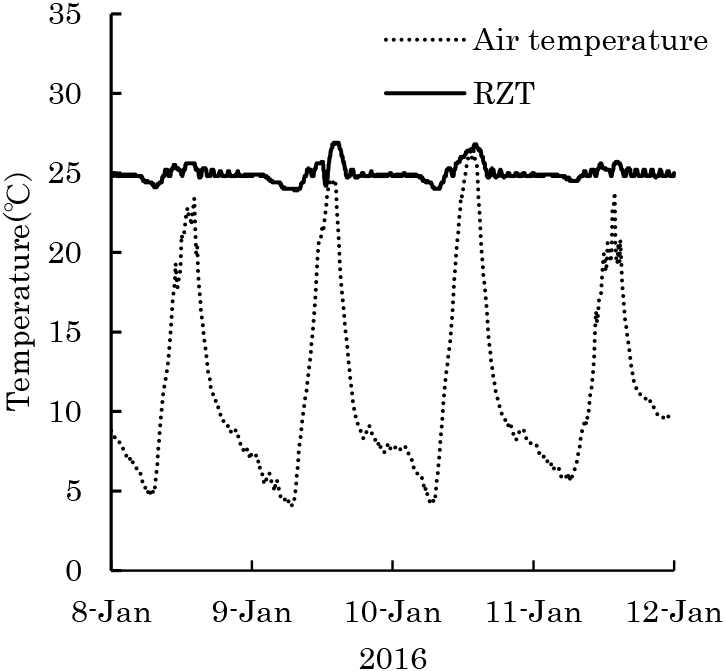
Changes in air temperature and root-zone temperature (RZT) in root-zone heating in a non-heated greenhouse with N.RECS in winter. RZT was kept about 25°C by root-zone heating using the N.RECS even at air temperatures below 5°C.
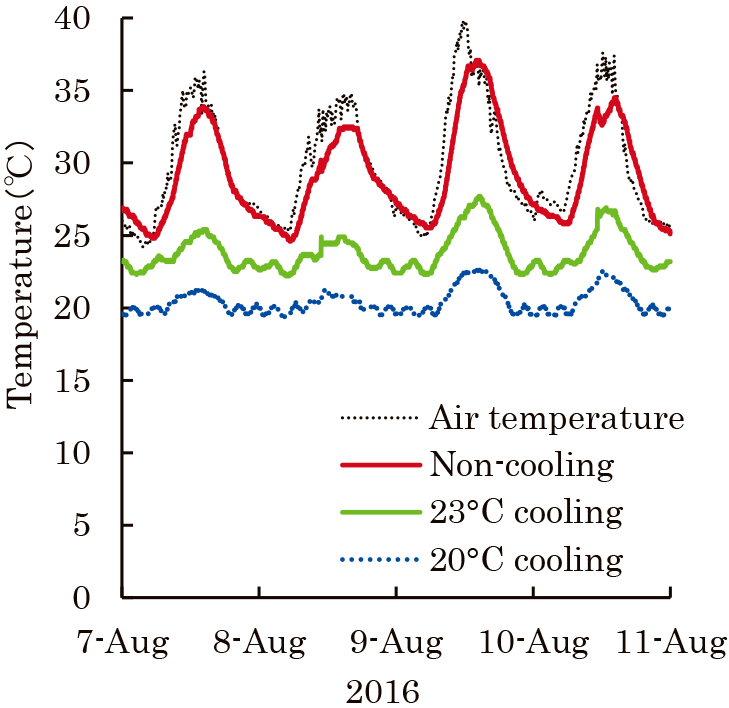
Changes in air temperature and root-zone temperature (RZT) in root-zone cooling with the N.RECS in summer. RZT of non-cooling increased to 30–35°C, consistent with the changes in air temperature, but RZT of 20°C cooling was maintained in a range from 20–23°C of RZT.
The effects of RZ heating and RZ cooling on the growth, flowering and energy consumption of RZ heating in winter were investigated by using N.RECS. Seedlings of tuberous begonias (Begonia × tuberhybrida) were used for RZ heating in winter (Muramatsu et al., 2018). The minimum air temperature/RZ heating were set at 12°C/24°C and 16°C/non-heating. The number of leaves, leaf area, flowering, number of flower buds and dry matter weight of the top at 12°C/24°C were significantly enhanced compared to those of 16°C/non-heating (Fig. 6). The energy consumption at 12°C/24°C was reduced total heating costs by 34% compared to that at 16°C/non-heating. In addition, growth and flowering of dwarf dahlia (Dahlia × hybrida), geranium (Pelargonium × hortorum), dwarf gerbera (Gerbera × hybrida), and primula (Primula obconica) were also promoted by RZ heating at 24°C even at air temperatures 4–6°C lower than those of conventional cultivation (Kubota et al., 2018; Muramatsu et al., 2018).
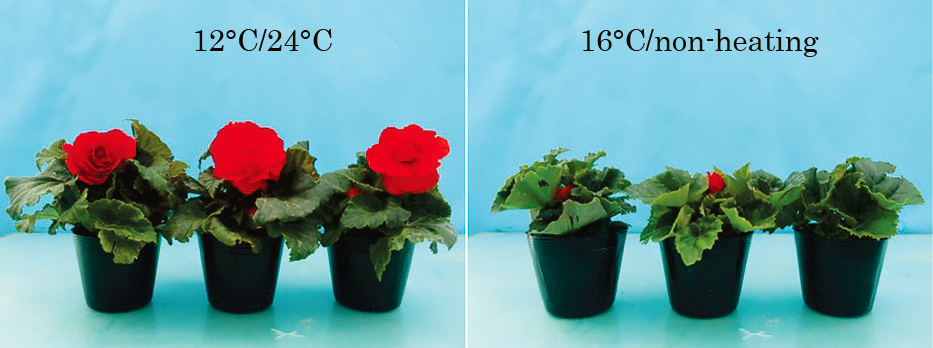
Effects of root-zone heating by the N.RECS on growth and flowering of tuberous begonias (Begonia × tuberhybrida) during winter. The minimum air temperature/root-zone temperature were set at 12°C/24°C and 16°C/non-heating. The growth and flowering at 12°C/24°C were significantly promoted compared to 16°C/non-heating.
RZ heating of cut gerbera flowers was also studied (Muramatsu et al., 2019a). In the case of cut flower production, the basic equipment was the same as that potted plants production; instead of insulated pot trays, EPS-covered coco-bags were placed directly on top of heat exchange panels, and gerberas were planted in the coco-bags. The minimum air temperature/RZ heating were set at 12°C/24°C and 16°C/non-heating. The results showed that energy consumption costs could be reduced by more than 30% with no significant differences between treatments in terms of the growth and yield of cut flowers.
Fuchsia (Fuchsia × hybrida) is susceptible to high temperatures, so the plants are grown at higher altitudes during summer. The experiment was conducted in a lowland greenhouse, Fujisawa, Kanagawa Prefecture, Japan, in summer (Kubota et al., 2018). Three treatments were set: non-cooling, 23°C RZ cooling and 20°C RZ cooling under the same air temperature condition. Forty-eight percent of the plants died under non-cooling, while all plants displayed healthy growth at 23°C and 20°C RZ cooling (Fig. 7). Similar to fuchsia, it was found that RZ cooling significantly enhanced the growth of the Rhodanthemum gayanum ‘Mercury’, which has no heat tolerance.

Effects of root-zone (RZ) cooling on growth of Fuchsia (Fuchsia × hybrida) during sammer. Average temperature ranged from 27 to 31°C during summer. All plants showed healthy growth with the 23°C and 20°C RZ cooling, but 48% of the plants died and had poor root growth in the non-cooling group.
In summary, N.RECS promoted growth and flowering in many floriculture plants with RZ heating in winter, and energy savings of more than 30% could be achieved; RZ cooling of low heat tolerant plants in summer also increased plant survival and healthy plant growth. Therefore, it is concluded that the N.RECS equipment enables both energy-saving cultivation in the winter and cooling cultivation in the summer under various conditions.
In the N.RECS experiments applied to each of the above species, RZT had a common effect on leaf area expansion in each species. In these experiments, the RZT was fixed at a certain value, but it was expected that the rate of leaf area expansion could be controlled by varying the RZT. Therefore, Muramatsu et al. (2019b) investigated the effect of variable RZT control on the rate of leaf area expansion using petunia (Petunia × hybrida) in winter. A digital camera was installed in a non-heated greenhouse with N.RECS and still images were taken daily from above the plants. Leaf images were extracted from the still images using image analysis software (Image J), and the actual leaf area was calculated from the number of pixels. The final target leaf area (100 cm2) and the target periods (30 and 45 days) were set in advance, and an exponential growth curve model was created from both. The RZT was adjusted to match the growth curve model to the measured leaf area as closely as possible. The results showed that the actual periods against the target periods of 30 and 45 days were 33 and 47 days, respectively, with a delay of only 2–3 days against the target. This indicates that RZT control by N.RECS can regulate leaf expansion growth with relatively good accuracy, and the technique may allow adjustment of the shipment timing for some floriculture plants. N.RECS can be installed on each bench in a greenhouse, so the RZT of each bench can be controlled independently. At present, it has been difficult to change the timing of shipments of plants grown simultaneously in the same greenhouse, but N.RECS will allow plants to be shipped at different times, which will greatly contribute to labor distribution.
As described above, it was demonstrated that the root-zone temperature has significant effects on plant growth in various floriculture plants. In addition, some experiments also showed that the application of N.RECS promoted the flowering of strawberry (Mizuno et al., 2017). Thus, N.RECS could be applied to the production of vegetables and other horticultural crops in the future.
Advanced protected horticulture routinely measures and controls environmental parameters such as air temperature, humidity, CO2 concentration, light intensity, day length and so on. On the other hand, in terms of the root-zone environments, soil moisture, EC, and pH are measured and controlled in soilless cultures, but the root-zone temperature is rarely controlled. Furthermore, other cultivation methods, such as pot culture and soil culture, provide little control of the root-zone environments. Therefore, root-zone temperature is an environmental control parameter that should be controlled in future agricultural production, and by applying root-zone temperature control as a standard technology for agricultural production, the growth of plants can be controlled more flexibly and save more energy.
In modern greenhouse technology, a good example of integrated environmental control of both top (T) and root zone (R) environments is the control of the irrigation amount and frequency based on cumulative solar radiation. However, T-R integrated environmental control using many environmental parameters, including root-zone temperature, has not yet been realized. T-R integrated environmental control technology is expected to play an important role in the development of modern greenhouse technology.